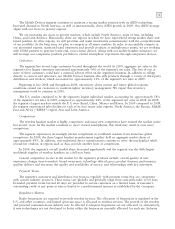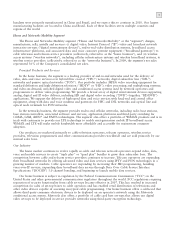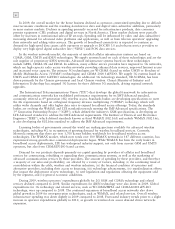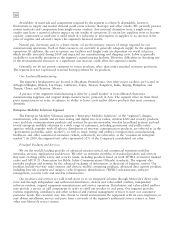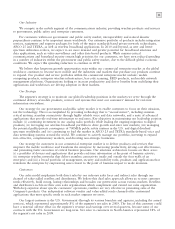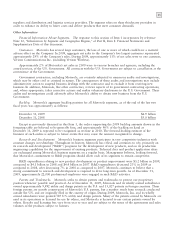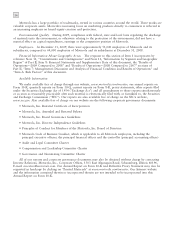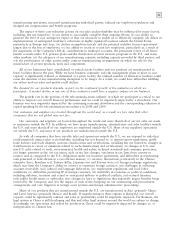Motorola 2009 Annual Report Download - page 21
Download and view the complete annual report
Please find page 21 of the 2009 Motorola annual report below. You can navigate through the pages in the report by either clicking on the pages listed below, or by using the keyword search tool below to find specific information within the annual report.
13
The segment manufactures and markets products in spectrum bands already made available by regulatory
bodies. These include voice and data infrastructure, mobile radios and portable or handheld units. Our products
operate both on licensed and unlicensed spectrum. In addition, new spectrum bands and modified regulations
provide possible opportunities for new business.
As television transmission and reception technology transitions from analog to more efficient digital modes,
various countries around the world are examining, and in some cases already pursuing, the redevelopment of
portions of the television spectrum. In the U.S., pursuant to federal legislation, analog television stations ceased
operation in the broadcast television spectrum on June 12, 2009. As a result of this transition, 108 MHz of
spectrum historically used for broadcast television is being redeveloped and deployed for new uses (the so-called
‘‘digital dividend’’ spectrum), including broadband and narrowband wireless communications. This spectrum can
provide new opportunities for Motorola and for our competitors. Under rules adopted by the FCC, this portion
of the spectrum (the 700 MHz band) will support new commercial and public safety communications systems.
Licenses for the majority of this spectrum have already been issued. Prior to the end of the transition from analog
to digital television on June 12, 2009, over 40 public safety customers were already implementing narrowband
700 MHz systems in areas where television incumbency was not an issue. Additional agencies are planning for
deployment of systems now that broadcast television is cleared from the 700 MHz band. The FCC is also making
provisions for a 700 MHz band nationwide public safety broadband network that may be built over the next
10-15 years. Public safety organizations have endorsed the use of Long Term Evolution (LTE) technology, a
technology in which Motorola is investing, for this broadband network. Canada also released a consultation
requesting industry input on making additional spectrum available for public safety use in the 700 MHz band
and decisions are expected to be released during 2010.
In addition to reallocating TV spectrum at 700 MHz for public safety and commercial use, in April 2009 the
FCC initiated an inquiry on developing a national broadband plan. The FCC indicated that this inquiry’s focus is
‘‘to enable the build-out and utilization of high-speed broadband infrastructure.’’ Over the remainder of 2009, the
FCC released a series of requests for input regarding various aspects of broadband across multiple markets
including healthcare, education, public safety and consumers. The FCC is required to provide a report to
Congress on its findings during 2010. In addition, Congress passed the American Recovery and Reinvestment Act
(ARRA) which includes federal funding for broadband deployment and Smart Grid deployment. These initiatives
to increase the availability of broadband and to support Smart Grid deployment may provide new business
opportunities.
Internationally, the ITU World Radio Conference held in Geneva in November 2007 identified spectrum that
could be made available as part of a ‘‘digital dividend’’ as television transitions from analog to digital technology
globally. Countries around the world are studying the potential size, timing and use of this potentially available
spectrum. During 2009, the European Commission issued a mandate to the pan-European regulatory body CEPT
asking for the best way to utilize the digital dividend spectrum, which in Europe is located at 790 - 862 MHz.
The CEPT provided a preferred bandplan for this digital dividend spectrum. The European Commission is now
preparing a spectrum decision expected to be offered to the European Parliament for adoption. If adopted, the
decision would be legally binding on the 27 member states of the European Union, providing a harmonized plan
in that area and potential opportunities for new commercial mobile broadband services and equipment sales
going forward. A number of other countries around the world have also indicated their intention to pursue the
availability of digital dividend spectrum.
Some of our operations use substances regulated under various federal, state, local and international laws
governing the environment and worker health and safety, including those governing the discharge of pollutants
into the ground, air and water, the management and disposal of hazardous substances and wastes and the cleanup
of contaminated sites. Certain of our products are subject to various federal, state, local and international laws
governing chemical substances in electronic products.
Backlog
The segment’s backlog was $2.4 billion at both December 31, 2009 and December 31, 2008. The 2009 order
backlog is believed to be generally firm and approximately 75% of that amount is expected to be recognized as
revenue during 2010. The forward-looking estimate of the firmness of such orders is subject to future events that
may cause the amount recognized to change.


